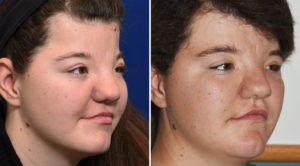Background: Many well known congenital skull deformities (craniosynostoses) are treated by early surgery, usually under one year of age. While this allows the developing brain more space to grow and have it help shape the overlying skull, the final shape of the skull is rarely ideally normal. Scar, growth potential and genetics all play a role in preventing a consistent and reliably formed convex skull shape.
Such secondary skull deformities are most manifest in the forehead. Between its visible large contribution to the face and the frequent bone irregularities and temporal hollowing that develops from prior surgeries, the forehead can lack a smooth and pleasing shape. Forehead recession and narrowing along with temporal depressions makes for a commonly seen disproportionate forehead contour. Many of these patients will also have small metal plates and screws across the forehead and brow bones as well as some full-thickness bone defects.
Case Study: This 22 year-old female was originally born with a bilateral coronal craniosynostosis. She has previously undergone both early and several subsequent fronto-orbital reconstructive procedures. Her forehead had a recessed and inverted shape and the temporal areas at the side of the forehead had marked hollowing. There were also several areas of tenderness over the forehead underneath which were palpable metal hardware.


The use of hydroxyapatite cement is largely restricted to such procedures as forehead reconstruction due to its high cost. ($100/gram) Its working properties also make it most easily and consistently used with wide open exposure of the bone site. These two reasons keep hydroxyapatite cement from more frequent use in aesthetic skull reshaping surgery.
Highlights:
1) Forehead reconstruction of large contour defects from congenital skull deformities is best treated by hydroxyapatite cement.
2) Hydroxyapatite cement offers a smooth and highly biocompatible contouring material for long-term persistence.
3) The high cost of hydroxyapatite cements makes their use more common in reconstructive forehead reconstruction and not aesthetic forehead augmentations.
Dr. Barry Eppley
Indianapolis, Indiana



